外研版高中英语(2019)必修一What’s really green 教学设计
- 格式:docx
- 大小:13.70 KB
- 文档页数:4
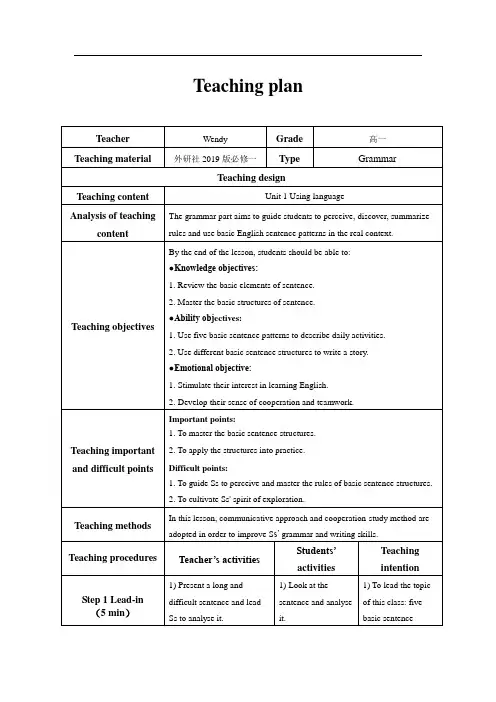
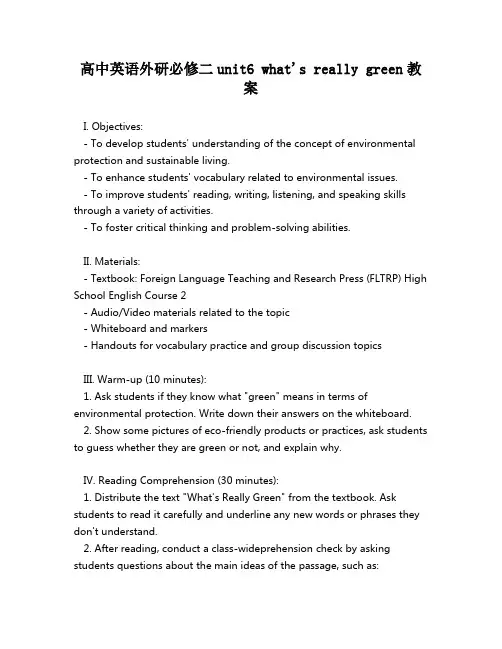
高中英语外研必修二unit6 what's really green教案I. Objectives:- To develop students' understanding of the concept of environmental protection and sustainable living.- To enhance students' vocabulary related to environmental issues.- To improve students' reading, writing, listening, and speaking skills through a variety of activities.- To foster critical thinking and problem-solving abilities.II. Materials:- Textbook: Foreign Language Teaching and Research Press (FLTRP) High School English Course 2- Audio/Video materials related to the topic- Whiteboard and markers- Handouts for vocabulary practice and group discussion topicsIII. Warm-up (10 minutes):1. Ask students if they know what "green" means in terms of environmental protection. Write down their answers on the whiteboard.2. Show some pictures of eco-friendly products or practices, ask students to guess whether they are green or not, and explain why.IV. Reading Comprehension (30 minutes):1. Distribute the text "What's Really Green" from the textbook. Ask students to read it carefully and underline any new words or phrases they don't understand.2. After reading, conduct a class-wideprehension check by asking students questions about the main ideas of the passage, such as:- What is greenwashing?- How can we tell if a product is really green?- Why is it important to be aware of greenwashing?V. Vocabulary Practice (20 minutes):1. Prepare handouts with key vocabulary words and phrases from the text. Divide students into pairs and have them work together to define the words using context clues or dictionaries.2. Conduct a whole-class review of the vocabulary, making sure each word or phrase is understood by all students.VI. Group Discussion (25 minutes):1. Provide students with several discussion topics related to the theme of environmental protection and sustainability. Examples include:- Is your school doing enough to be environmentally friendly? What more could be done?- What changes can individuals make to live a greener lifestyle?- How do you think government policies could encourage businesses to be more environmentally responsible?2. Divide students into small groups and assign one topic to each group. Give them 15 minutes to discuss and prepare a short presentation.3. Have each group present their findings to the class, followed by a brief Q&A session.VII. Listening and Speaking Practice (25 minutes):1. Play an audio or video clip related to environmental protection or green living. This could be a TED talk, a news report, or an interview.2. After watching/listening, have students work in pairs to summarize the main points and share their thoughts on the content.3. Select a few pairs to share their summaries and opinions with the whole class.VIII. Wrap-up (10 minutes):1. Review the main concepts covered in the lesson and emphasize the importance of being aware of greenwashing and taking personal responsibility for protecting the environment.2. Assign homework: Students should write a short essay discussing how they plan to incorporate environmentally friendly practices into their daily lives.IX. Assessment:Homework assignments will be evaluated based on content, organization, grammar, and vocabulary. Class participation and group discussions will also be taken into consideration when assessing students' overall understanding of the topic.In conclusion, this lesson plan aims to educate students about the significance of environmental protection and sustainability while improving their language skills. By engaging them in various interactive activities, students will gain a deeper understanding of the concept of "green" and develop critical thinking skills necessary to navigate theplexities of environmental issues.。
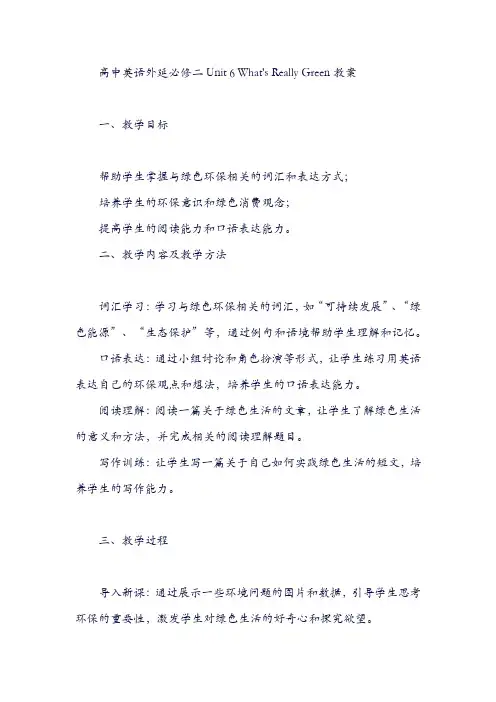
高中英语外延必修二Unit 6 What's Really Green教案一、教学目标帮助学生掌握与绿色环保相关的词汇和表达方式;培养学生的环保意识和绿色消费观念;提高学生的阅读能力和口语表达能力。
二、教学内容及教学方法词汇学习:学习与绿色环保相关的词汇,如“可持续发展”、“绿色能源”、“生态保护”等,通过例句和语境帮助学生理解和记忆。
口语表达:通过小组讨论和角色扮演等形式,让学生练习用英语表达自己的环保观点和想法,培养学生的口语表达能力。
阅读理解:阅读一篇关于绿色生活的文章,让学生了解绿色生活的意义和方法,并完成相关的阅读理解题目。
写作训练:让学生写一篇关于自己如何实践绿色生活的短文,培养学生的写作能力。
三、教学过程导入新课:通过展示一些环境问题的图片和数据,引导学生思考环保的重要性,激发学生对绿色生活的好奇心和探究欲望。
词汇学习:通过PPT展示和讲解,帮助学生掌握与绿色环保相关的词汇,并引导学生将它们应用到实际的语境中。
口语表达:将学生分成小组,让他们讨论自己对于环保的看法和做法,并扮演不同的角色进行模拟对话,提高学生的口语表达能力。
阅读理解:让学生阅读一篇关于绿色生活的文章,并完成相关的阅读理解题目。
教师可以给予一定的指导和帮助。
写作训练:让学生写一篇关于自己如何实践绿色生活的短文,并分享给大家。
教师可以给予一定的指导和评价。
小结与布置作业:对本节课所学内容进行小结,并布置相关作业,包括复习本节课所学词汇和表达方式、写一篇关于自己绿色生活的短文等。
四、教学评价与反馈对学生的表现进行评价,包括词汇掌握情况、口语表达能力和阅读理解能力等方面;对学生的学习过程进行观察和记录,了解学生在小组讨论、角色扮演等环节中的参与度和表现;通过作业和测试等方式检验学生对本节课所学内容的掌握情况,及时发现并解决学生在学习中存在的问题;对自己的教学方法和效果进行反思和总结,不断改进和完善自己的教学策略。
五、教学资源与工具PPT课件:包含本节课所需词汇、文章、题目等内容;图片和数据资料:展示环境问题、绿色生活方式的图片和数据资料;角色扮演道具:为角色扮演活动准备一些道具或模拟场景;教学视频或音频:可以播放一些与环保相关的视频或音频资料,帮助学生深入了解环保问题。
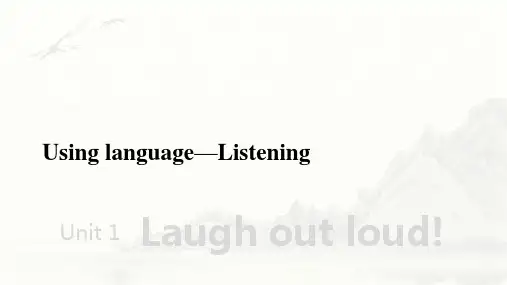
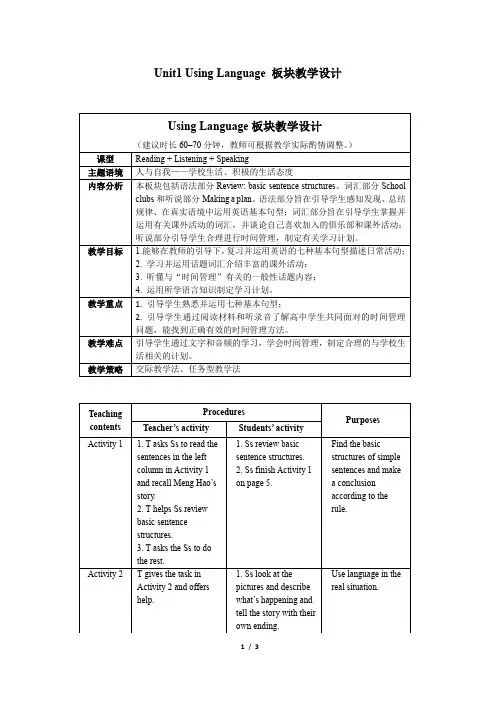

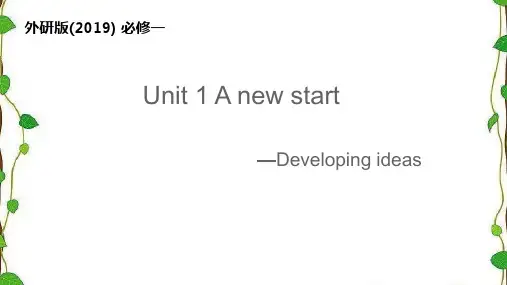

外研社(19)高中英语必修一Unit 2 Exploring English--Developing ideas教案Teaching objectives:1.To help the students understand the text and experience the confusion and misunderstanding in their study.2.To deepen the understanding of the theme of the unit based on the students’ own English learning experiences.3.To develop a learning and thinking mode of paying close attention to slang words as well as their cultural connotation.4.To get to know the contents, stylistic features and writing methods. To briefly describe an experience of misunderstanding some certain English expressions.Evaluation objectives:After the class, the students are expected to be able to:1.Understand the text.2.Get a general of some slang words.3.Know more about the differences between English and Chinese.Teaching key and difficult points:1.Enable the students to understand the text and ask them to compare, analyse and judge the content of the text and deepen the understanding of the theme of the unit.2.Help the students to develop the students’ logical thinking, critical thinking and creative thinking.3.Guide the students to develop the students’ cross-cultural awareness.Teaching methods:Task-based Approach; Cooperative LearningTeaching procedures:Step1:Presentation1.Ask the students to guess the meaning of “big potato”according to the following dialogue.A:You know what, the guy we talked with is a big potato in our company.B:You don’t say.2.Read the following expressions and guess their meanings.(Activity1, Page20)What’s up?Ring a bellSmall potatoesToilet waterAt sixes and sevensGreen figuresPull up one’s socksSuggested answers:What’s up?--What’s going on?Ring a bell--to sound familiarSmall potatoes--something unimportant or insignificantToilet water--a light perfume that does not have a very strong smellAt sixes and sevens--in a confused, badly-organized, or difficult situationGreen figures--natural ability in growing plantsPull up one’s socks--to make an effort to improve your work or behavior because it is not good enough.Step2:Fast readingAsk the students to read the four posts quickly and get to know where the four writers’“puzzles”lie in while learning English.Yancy---Sophie--Julien--Zheng Xu--Step3:Careful readingAsk the students to read the text quickly and finish Activity3 on Page22.Help them solve their puzzles.Suggested answers:a---Sophie’s post b---Zheng Xu’s post c---Yancy’s post d---Julien’s post Step4: Key and difficult pointsRead the text carefully again and help the students understand and analyse some long sentences.1.Here are some of our favorites,to remind us that some of the English we learn in the classroom is rather different from the English in the outside world!本句中的remind 是“提醒”的意思。
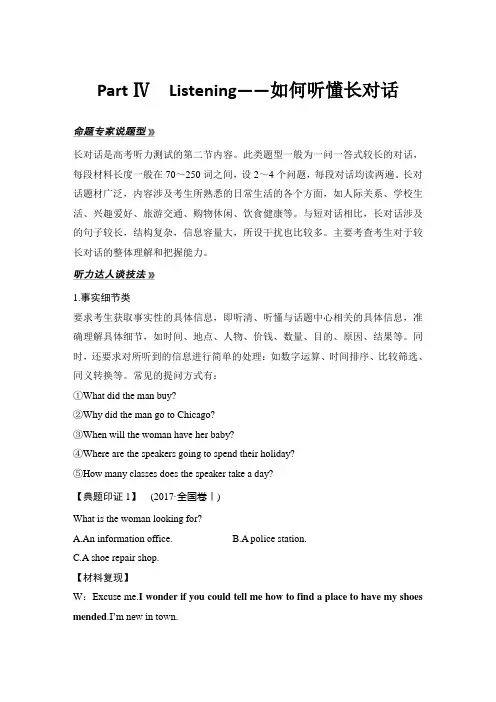
Part ⅣListening——如何听懂长对话长对话是高考听力测试的第二节内容。
此类题型一般为一问一答式较长的对话,每段材料长度一般在70~250词之间,设2~4个问题,每段对话均读两遍。
长对话题材广泛,内容涉及考生所熟悉的日常生活的各个方面,如人际关系、学校生活、兴趣爱好、旅游交通、购物休闲、饮食健康等。
与短对话相比,长对话涉及的句子较长,结构复杂,信息容量大,所设干扰也比较多。
主要考查考生对于较长对话的整体理解和把握能力。
1.事实细节类要求考生获取事实性的具体信息,即听清、听懂与话题中心相关的具体信息,准确理解具体细节,如时间、地点、人物、价钱、数量、目的、原因、结果等。
同时,还要求对所听到的信息进行简单的处理:如数字运算、时间排序、比较筛选、同义转换等。
常见的提问方式有:①What did the man buy?②Why did the man go to Chicago?③When will the woman have her baby?④Where are the speakers going to spend their holiday?⑤How many classes does the speaker take a day?【典题印证1】(2017·全国卷Ⅰ)What is the woman looking for?A.An information office.B.A police station.C.A shoe repair shop.【材料复现】W:Excuse me.I wonder if you could tell me how to find a place to have my shoes mended.I’m new in town.M:Ah, there is a good shop not far from here.Go straight ahead and walk about three blocks.I can’t remember the name of the shop, but you’ll find it.It’s near the police station.By the way, you know about the town guide? It’s a thin book and has all kinds of useful information.You’ll find one in any bookstore.W:Thanks a lot! You’ve been so helpful.Let’s see.Did you say the repair shop was three blocks away from here?M:Exactly.W:Thanks again.【解题思路】本题属于事实细节类,根据材料中“I wonder if you could tell me how to find a place to have my shoes mended.”可知,女性说话者正在寻找修理鞋的地方,故应选C项。
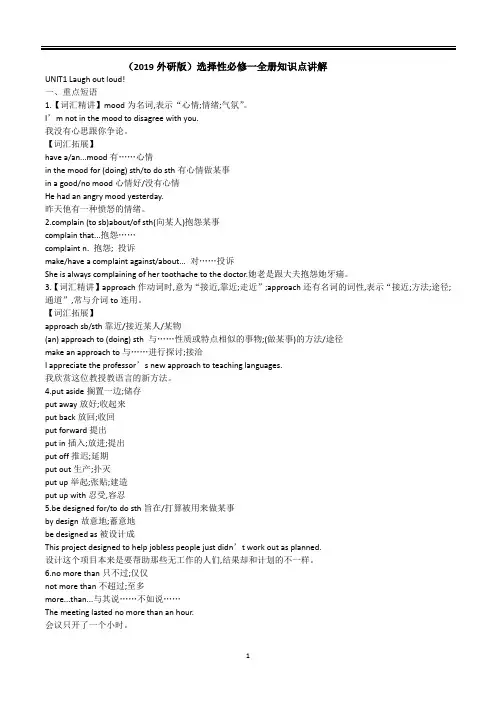
(2019外研版)选择性必修一全册知识点讲解UNIT1 Laugh out loud!一、重点短语1.【词汇精讲】mood为名词,表示“心情;情绪;气氛”。
I’m not in the mood to disagree with you.我没有心思跟你争论。
【词汇拓展】have a/an...mood有……心情in the mood for (doing) sth/to do sth有心情做某事in a good/no mood心情好/没有心情He had an angry mood yesterday.昨天他有一种愤怒的情绪。
plain (to sb)about/of sth(向某人)抱怨某事complain that...抱怨……complaint n. 抱怨; 投诉make/have a complaint against/about... 对……投诉She is always complaining of her toothache to the doctor.她老是跟大夫抱怨她牙痛。
3.【词汇精讲】approach作动词时,意为“接近,靠近;走近”;approach还有名词的词性,表示“接近;方法;途径;通道”,常与介词to连用。
【词汇拓展】approach sb/sth靠近/接近某人/某物(an) approach to (doing) sth 与……性质或特点相似的事物;(做某事)的方法/途径make an approach to与……进行探讨;接洽I appreciate the professor’s new approach to teaching languages.我欣赏这位教授教语言的新方法。
4.put aside搁置一边;储存put away放好;收起来put back放回;收回put forward提出put in插入;放进;提出put off推迟;延期put out生产;扑灭put up举起;张贴;建造put up with忍受,容忍5.be designed for/to do sth旨在/打算被用来做某事by design故意地;蓄意地be designed as被设计成This project designed to help jobless people just didn’t work out as planned.设计这个项目本来是要帮助那些无工作的人们,结果却和计划的不一样。
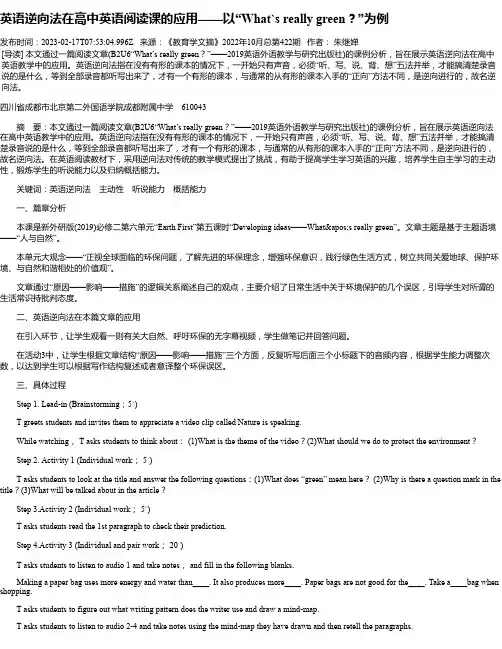
英语逆向法在高中英语阅读课的应用——以“What`s really green?”为例发布时间:2023-02-17T07:53:04.996Z 来源:《教育学文摘》2022年10月总第422期作者:朱继婵[导读] 本文通过一篇阅读文章(B2U6“What’s really green?”——2019英语外语教学与研究出版社)的课例分析,旨在展示英语逆向法在高中英语教学中的应用。
英语逆向法指在没有有形的课本的情况下,一开始只有声音,必须“听、写、说、背、想”五法并举,才能搞清楚录音说的是什么,等到全部录音都听写出来了,才有一个有形的课本,与通常的从有形的课本入手的“正向”方法不同,是逆向进行的,故名逆向法。
四川省成都市北京第二外国语学院成都附属中学610043摘要:本文通过一篇阅读文章(B2U6“What’s really green?”——2019英语外语教学与研究出版社)的课例分析,旨在展示英语逆向法在高中英语教学中的应用。
英语逆向法指在没有有形的课本的情况下,一开始只有声音,必须“听、写、说、背、想”五法并举,才能搞清楚录音说的是什么,等到全部录音都听写出来了,才有一个有形的课本,与通常的从有形的课本入手的“正向”方法不同,是逆向进行的,故名逆向法。
在英语阅读教材下,采用逆向法对传统的教学模式提出了挑战,有助于提高学生学习英语的兴趣,培养学生自主学习的主动性,锻炼学生的听说能力以及归纳概括能力。
关键词:英语逆向法主动性听说能力概括能力一、篇章分析本课是新外研版(2019)必修二第六单元“Earth First”第五课时“Developing ideas——What's really green”。
文章主题是基于主题语境——“人与自然”。
本单元大观念——“正视全球面临的环保问题,了解先进的环保理念,增强环保意识,践行绿色生活方式,树立共同关爱地球、保护环境、与自然和谐相处的价值观”。
2022新高考-外研版-必修一-写作(读后续写-专项练习5篇)读后续写1阅读下面材料,根据其内容和所给段落开头语续写两段,使之构成一篇完整的短文。
Once there was a little boy called Adam who came from a rich family. He was a young student at primary school and was very clever. He always gained good marks in his assessment exams.Adam got everything he wanted, such as toy cars, airplane models, water guns and so on. His parents bought him whatever he wanted, and Adam loved to add new items to his collection of toys. One day he went out to a store with his mother and in the toy section he found a very cool toy car which could play different kinds of sounds that a car could make. He was surprised to see that kind of toy car, so he ran to his mother and told her everything about it. Adam took his mother to the toy section to show how it worked. However, his mother refused to buy it for him because he already had a lot of toy cars. Adam was sad and wondered why his mother did not buy it for him, especially/since that toy car was rather cheap.Two weeks later, Adam and his mother went to the same store again. Adam thought that his mother would buy it for him this time, so he asked his mother for the toy car again. His mother ignored him because she was looking for something else. But Adam really wanted the toy car.So, while his mother was busy looking for some other items, he took the toy car and put it inside his backpack. The salesman saw Adam stealing the toy car and tried to stop him. Adam tried to run but the salesman caught him. Adam started to cry. His mother heard his voice and ran to him. She was shocked to see the salesman holding her son.注意:1.续写词数应为150左右;2.请按照如下格式在相应位置作答。
主题:2019外研版高中英语必修一教师用书一、概述2019年外研版高中英语必修一教师用书是教师在备课和教学过程中重要的参考资料。
它涵盖了教材的内容梳理、教学建议、评价方式等多方面的信息,帮助教师更好地进行教学工作。
本文将就该教师用书进行介绍和分析,并就如何有效使用该教师用书提出建议。
二、教师用书的内容梳理2019外研版高中英语必修一教师用书主要包括以下内容:1. 教材内容梳理:该部分对教材内容进行了详细的分析和梳理,包括每个单元的重点词汇、语法、话题和文化背景等内容,帮助教师更好地把握教学重点和难点。
2. 教学建议:该部分为教师提供了丰富的教学建议,包括课堂教学设计、教学方法和技巧、教学资源推荐等,帮助教师更好地设计教学方案和提高教学效果。
3. 评价方式:该部分介绍了多种评价方式和评价标准,帮助教师科学有效地对学生进行评价,促进学生学习的全面发展。
4. 备课参考:该部分提供了丰富的备课参考资料,包括课件、教案、练习题等,为教师备课提供了便利。
三、使用教师用书的建议针对2019外研版高中英语必修一教师用书,笔者提出以下建议,希望能够帮助教师更好地使用该教师用书:1. 充分了解教师用书的内容和结构,把握其主要功能和用途,为教学服务。
2. 根据教师用书的内容,结合教学实际,灵活运用其中的教学建议和备课参考,设计符合自己教学风格和学生特点的教学方案。
3. 精心选择和使用教师用书中的评价方式和评价标准,科学公正地对学生进行评价,并针对评价结果调整教学策略。
4. 主动参与教师用书的更新和优化,积极提出改进建议和意见,为教师用书的完善和提升贡献自己的力量。
四、结语2019外研版高中英语必修一教师用书是教师在教学过程中重要的参考资料,它能够帮助教师更好地把握教材内容,设计教学方案,提高教学效果。
教师应该充分了解教师用书的内容和结构,灵活运用其中的教学建议和备课参考,科学公正地对学生进行评价,并积极参与教师用书的更新和优化,以提高教学质量,促进学生全面发展。
一、教材内容分析本板块呈现了从另一角度反映单元主题的课文,语篇类型为记叙文,记叙了一名自然摄影师在美国黄石国家公园的一次惊心动魄的拍摄经历;读写部分的范文介绍了丹顶鹤的基本信息。
通过这一板块的学习,学生能够进一步理解人与动物之间的关系,最终形成爱护动物、尊重动物、尊重自然、保护生态的正确价值观。
二、教学目标1. 通过小组合作完成语言的组织、提炼和内化,最后在班上有条理地、流畅地介绍一个表现人与动物关系的电影或故事;2. 树立人与动物和谐相处的意识,关爱动物,尊重动物,保护动物;3. 通过自我评价和自我反思,发现问题并解决问题;三、学习者特征分析1、高中生各种认知能力不断完善,思维能力更加成熟。
2、抽象逻辑思维、辩证思维和创造性思维有了很大发展,学习自觉性明显提升。
2四、教学重点、难点运用所学语言知识有条理地介绍表现人与动物关系的电影或故事。
五、教学方法视听教学法、交际教学法六、教学过程教学过程教师活动学生活动设计意图时间Unit 5Into the wild素养进阶训练(六)WritingⅠ.应用文写作根据要求写一篇有关濒危动物——金丝猴的短文。
内容包括:1.栖息地:中国;2.外貌:金黄色,有点灰;尾巴和身体一样长;3.生活环境:海拔1,500~3,000米的森林;4.生活习性:群居,吃水果、干果,在树上活动;5.它们的数量减少了,呼吁人们保护金丝猴。
注意:词数80左右。
___________________________________________________________ ___________________________________________________________ ______________________________________________________________________________________________________________________ ___________________________________________________________ ___________________________________________________________ ___________________________________________________________ ___________________________________________________________ 答案The Golden MonkeyGolden monkeys live in China.They are protected by Chinese government.Their fur is golden and a bit grey.Their tails are as long as their bodies.The male golden monkeys are big and strong while the female ones are much smaller.Golden monkeys live in fores ts which are 1,500—3,000 metres above the sea level.They like living in familygroups.They feed on fruits, nuts, tree leaves and so on.But now their number is getting smaller and smaller.Our government has built some nature reserves to protect them. We hope more and more people will understand the importance of protecting golden monkeys. We also hope that people will stop hunting golden monkeys.Ⅱ.概要写作阅读下面短文,根据其内容写一篇60词左右的内容概要。
Unit 1 A new start Period 2 Understanding ideas(My First Day at Senior High)高中英语外研版(2019)必修第一册教材解读本课是高中英语外研版新教材Unit 1第二课时,通过记叙的方式主要介绍了一位高中新生第一天到校观察和接触到的人、事儿以及个人的感受,内容紧密结合学生的现实生活。
我们可以根据学校,班级的情况,布置学生做自我介绍,可以说自己的学校或在校的一个特别时刻或者感受。
要淡化语言点和语法知识的简单传授,采用新课标的“学习活动”来展开教学,不断培养英语学科的核心素养,从而扩大课堂的语料输入量及学生的语言输出量。
教学目标To read for the main idea of the passageTo describe pictures according to the passageTo read for detailed information and figure out author’s feelingsTo talk about student’s feelings and experiences on their first day of senior high 教学重难点1.By analyzing the reading material, students know how to describe their experiences and feelings about school life.2.To write a diary stating your own first day at senior high教学手段:多媒体课件Teaching proceduresStep1:Warming up1.Warming up by asking Questions1). When did you get to school? How did you get here?2). What classes do you have? Tell us the ones you are interested in.3). How many new classmates did you meet? Did you know some of them before?4). Did you make any new friends? Describe one of them.5). How was your feelings at Senior High?2.Warming up(1) using the children’s first schooling experience to introduce today’s topic.(2)showing four pictures to recall the students’ memory of their first day at Senior High.Step2:Reading1.Fast reading:Skimming and scanning, find out what the author wrote in hisdiary about his first day at senior high.The author wrote about the school campus, his new English teacher, the firstclass, an embarrassing moment and his feelings in the diary.2.Careful reading for detailed information find out the main ideas of each part.Part1 (para1) His feelings before going to schoolPart2 (Para2) He met his English teacherPart3 (Para3-7) Experiences on the first English classPart4 (Para8) His feelings after the English class3.Read carefully and think about the following questions.The passage is written in ______ order.Does Meng Hao’s feelings change?plete Meng Hao’s experiences with expressions from the passage.(1)课文缩写(知识迁移)It was Meng hao’s first day at_________, so he got up early and ______________to his new school with excitement. When arriving at the school, he found the campus was still quiet, so he decided to _________. Just then, he met a man, who, later, he ______find out was his English teacher. What a coincidence!During the class, he was nervous about introducing himself in front of the class. With_______, he began, but everyone laughed. It turned out that he and his teacher _________. Mr. Meng said that challenges in senior high might put them _______. He advised everyone to ______and prepare themselves for the unknown.With the English teacher’s support, Meng hao thought he had had _________to his new school life.Step3 SummaryFill in the blanks and try to retell the Diary My First Day at Senior high.课后反思:本单元以“A new start”为主题,描写了高中新生第一天的学校生活和丰富多彩的活动,旨在培养学生热爱新学校、新班级和新同学的情感态度,树立正确的英语学习观。
The teaching plan of What’s really green?
Name:
Grade: Senior One
Subject: What’s really green?
Lesson type: Reading and speaking
Teaching Time : 45 minutes
Teaching Context: Analysis of Teaching Material This is a listening and speaking lesson. The lesson focus on talking about “green truths”, aiming at letting students grasp the main idea of a passage through subheadings. The topic is closely related to students’ real life, and in accord with students’ cognitive level,, thus can make students learn meaningfully and build students a confidence of English learning.
Analysis of Students: The objects of this lesson are the students in Senior One. Students in this phase have already learned a great number of words and can express their opinions. However, they lack the ability of systematic autonomous language learning and some students lack confidence of English learning. Therefore, it requires teachers to set up the task from easy to the advanced to guide them. What’s more, they tend to focus on image thinking because of the absence of the mature, abstract and logical thinking, thus teachers should design various interesting, fun and relaxing activities to sustain students’ interests and attention. Teaching Aims:
Aims of knowledge:
1 master and use some important words
2 be able to think logically and critically
Aims of ability: 1 be able to understand the passage through subheadings2 be able to make comments on common facts in our real life3 be able to use transitional words properly
Aims of emotion: 1 taste the happiness of communicating in English2 arouse students’ awareness of living a green life and protect the environment3 be active and cooperative in teamwork, and enjoy the sense of achievement in cooperation
Aims of strategy:1 master some methods of Independent learning 2 be well versed in transforming input to output.
Difficult Points: learn to think logically and critically
Teaching Methods: 1 Task-based Teaching Method2
The Natural Approach3 The Communicative Language Teaching Method4 Computer-assisted Instruction
Teaching Aids: 1 text book 2 power point3 a video clip
Teaching procedures:
Step I Leading-in
Answer some questions about green living in activity one.1 Which shopping bag is more environmentally friendly?
A plastic bag
A paper bag
Neither of these
2 What should you do to save energy?
Turn off a device.
Unplug a device.
Neither of these.3 What food is better for the environment?
Food produced near to where you live.
Food produced far from where you live.
It depends.4 Which uses less water?
Taking a bath. Taking a shower.
It depends.
Step II
Skimming
1. Read the subheadings in the passage and decide if they are true or false. Then read the passage and check the answers.
Paper shopping bags are better than plastic ones.
When you turn off a device, it stops using power.
Eating local food is good for the environment.
It’s better to take a shower than a bath.2. What’s the main idea of the passage?
It discusses some common _______ which have been shown to ______ or completely ______.
Step III Scanning
Read the effects and complete the causes.
Causes effects Making a paper bag uses more energy Paper bags are not good for the environment. and water than making a plastic bag.______________ Turning off a device won’t stop it from using power._____________ Eating local food isn’t always better for the environment.________________ It’s not always better to take a shower than a bath.
Step IV Presentation Please give a talk about one of the “green truths” in the passage. EX: Some people think.... because....However, it's not completely true because...Therefore/Thus, we should...
Step V Watch a video and learn some “green” actions.
Step VI Discussion What can we do to become “greener”?
Step VII Group work
Design a poster to call on people to protect our earth.
Step VIII Assignment
Write a short passage on the topic of “What can you do to become greener ?” using some transitional words.。